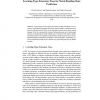1222 search results - page 56 / 245 » Machine Learning of Temporal Relations |
103
click to vote
IJCAI
1997
15 years 1 months ago
1997
Identifying user-dependent information that can be automatically collected helps build a user model by which 1) to predict what the user wants to do next and 2) to do relevant pre...
117
click to vote
TNN
2010
14 years 6 months ago
2010
Abstract--Recently, sparse approximation has become a preferred method for learning large scale kernel machines. This technique attempts to represent the solution with only a subse...
128
click to vote
COST
2009
Springer
14 years 9 months ago
2009
Springer
Synchrony is claimed by psychology as a crucial parameter of any social interaction: to give to human a feeling of natural interaction, a feeling of agency [17], an agent must be a...
188
click to vote
ML
2011
ACM
14 years 6 months ago
2011
ACM
Abstract. Type Extension Trees (TET) have been recently introduced as an expressive representation language allowing to encode complex combinatorial features of relational entities...
100
click to vote
ECCV
2006
Springer
16 years 1 months ago
2006
Springer
This paper presents a learning based approach to tracking articulated human body motion from a single camera. In order to address the problem of pose ambiguity, a one-to-many mappi...

